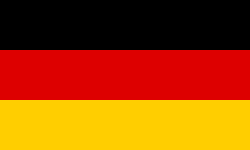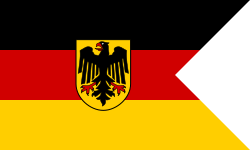Flag of Germany facts for kids
The flag of Germany (German: Bundesflagge) was adopted in its present form in 1919. It was readopted with the new constitution of 1949. It has three colours and is made of three equal horizontal bands coloured black (top), red, and gold (bottom).
The Dienstflagge or service flag is the version of the flag for government use. It has the national coat of arms in the centre. Ships of the German Navy use this flag with a triangle cut out of the end as an ensign.
Some states use the national flag with the state coat of arms as a state flag.
Under the Nazi government between 1933 and 1945, Germany used a different flag with a swastika on it. It is not legal to put up this flag in Germany now.
Images for kids
-
The German Unity Flag is a national memorial to German reunification that was raised on 3 October 1990. It flies in front of the Reichstag building in Berlin (seat of the German parliament).
-
The Stadtweinhaus in Münster with banners displayed in mourning (note the black ribbons atop each staff) after the death of former German president Johannes Rau in 2006
-
German football fans during a match against Ecuador in the 2006 FIFA World Cup. It was the first time that so many flags could be seen at the same time in the history of the federal republic. Some flags seen here contain the federal coat of arms and must not be confused with the Bundesdienstflagge, which displays the Bundesschild and may only be used by government authorities. A few Ecuadorian flags can be seen in the background.
See also
 In Spanish: Bandera de Alemania para niños
In Spanish: Bandera de Alemania para niños











